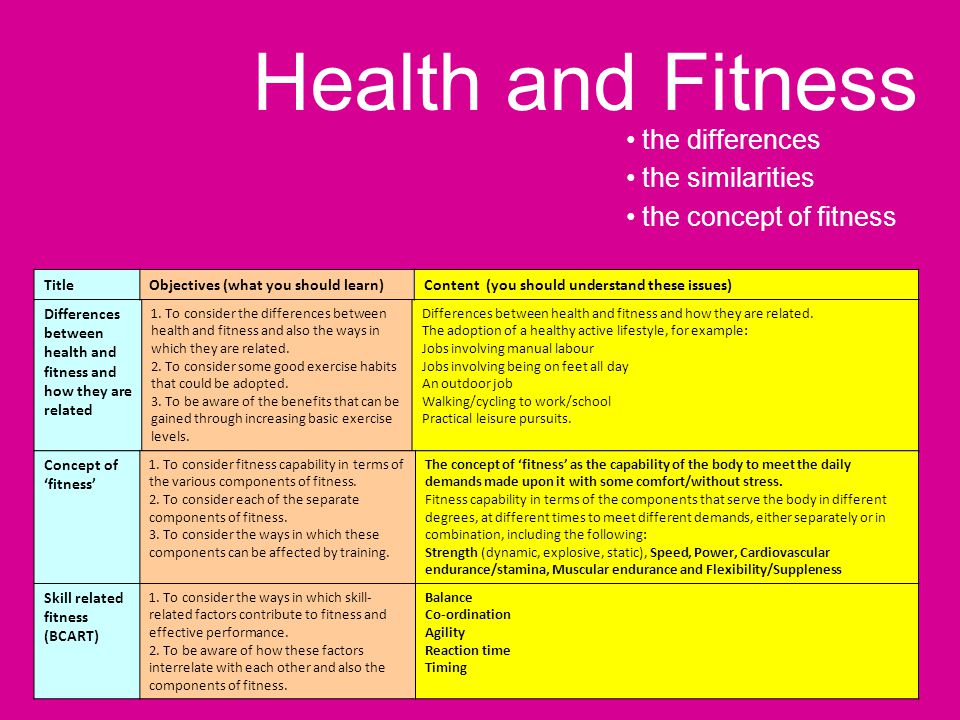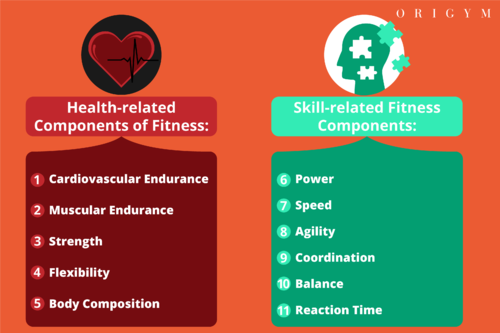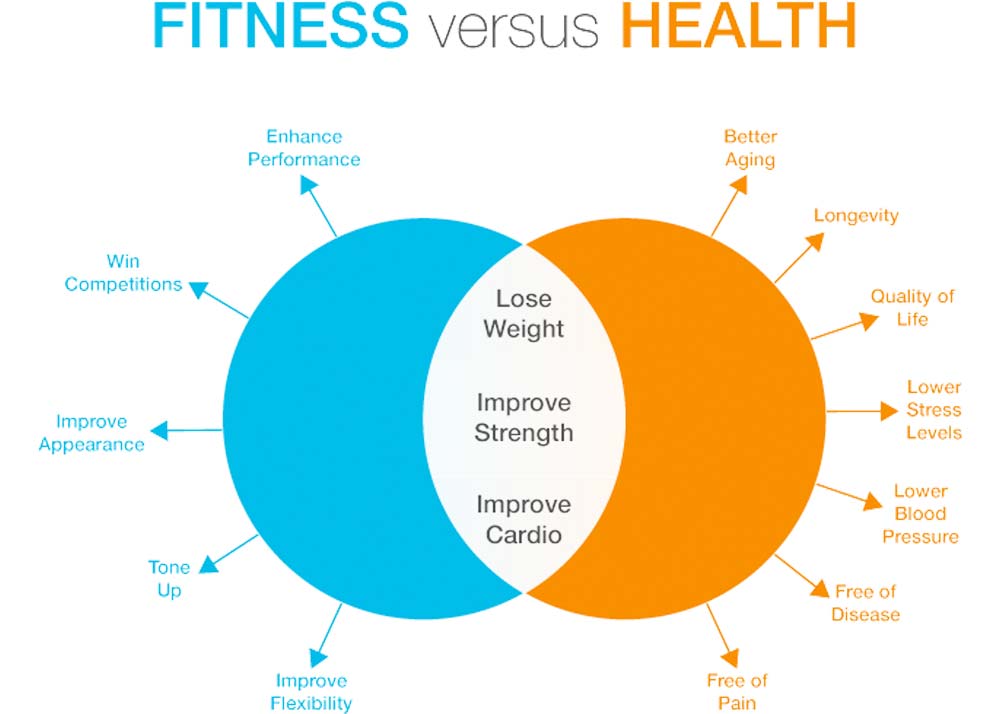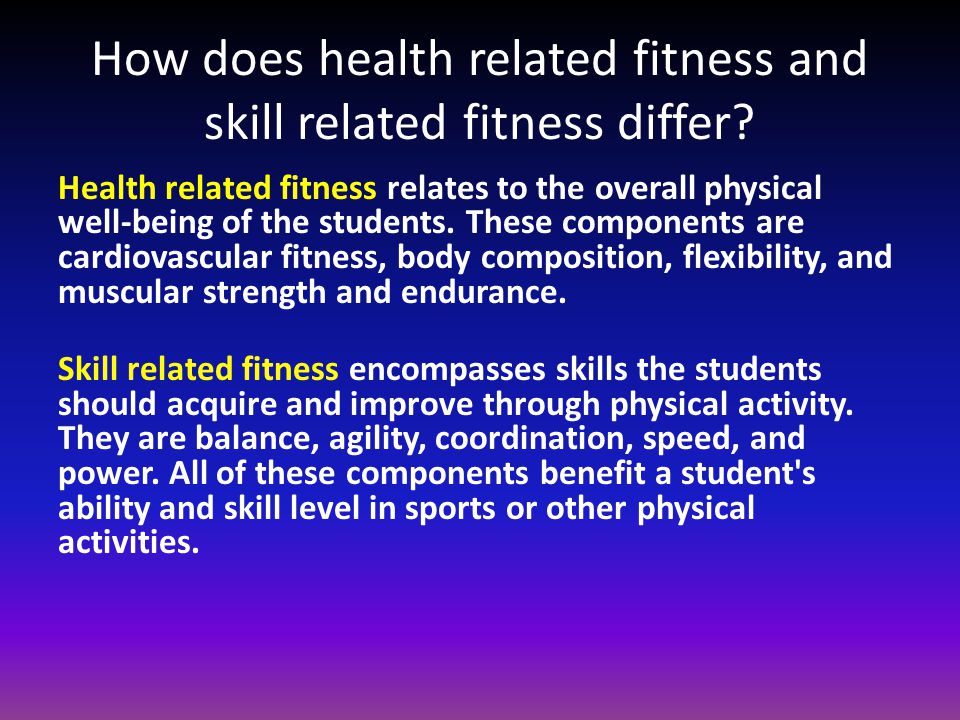Understanding the Distinction between Health and Skill-Related Fitness
When it comes to fitness, it’s important to distinguish between health and skill-related aspects. While both play a crucial role in overall well-being, they have distinct focuses. Health-related fitness refers to the physical components that contribute to your overall health, such as cardiovascular endurance, muscular strength, flexibility, and body composition. On the other hand, skill-related fitness involves abilities and qualities that are specific to activities or sports, including agility, speed, coordination, power, and reaction time. By understanding the difference between these two dimensions of fitness, you can tailor your exercise routine to meet your personal goals and achieve a well-rounded level of fitness.
Definition of Health and Skill-Related Fitness
Health and skill-related fitness are two distinct concepts that are often used interchangeably in discussions about physical fitness. However, it is important to understand the difference between these two terms in order to design and implement effective exercise programs and achieve personal fitness goals.
Health-Related Fitness
Health-related fitness refers to the overall state of an individual’s physical wellbeing. It is a measure of how well your body functions and how capable you are of performing daily tasks and activities. The components of health-related fitness include cardiorespiratory endurance, muscular strength, muscular endurance, flexibility, and body composition. These components work together to contribute to your overall health and quality of life.
Skill-Related Fitness
On the other hand, skill-related fitness focuses on the specific abilities and skills required for various sports and physical activities. While health-related fitness is more holistic in nature, skill-related fitness is more specialized and specific to particular sports or activities. The components of skill-related fitness include agility, balance, coordination, power, reaction time, and speed. These components are necessary to excel in sports and improve athletic performance.
Components of Health-Related Fitness
In order to enhance your overall physical wellbeing and health, it is important to pay attention to the various components of health-related fitness.
Cardiorespiratory Endurance
Cardiorespiratory endurance refers to the ability of your cardiovascular and respiratory systems to supply oxygen to your muscles during prolonged periods of physical activity. Regular aerobic exercise, such as running, swimming, or cycling, can increase your cardiorespiratory endurance and improve your overall health.
Muscular Strength
Muscular strength is the maximum force your muscles can exert against resistance. Building muscular strength through resistance training exercises, such as weightlifting, can help improve your ability to perform daily tasks, prevent injuries, and maintain good posture.
Muscular Endurance
Muscular endurance is the ability of your muscles to exert force repeatedly over a period of time. This is especially important for activities that require sustained muscle contractions, such as carrying heavy objects or participating in endurance sports. Regular strength training exercises with lighter weights and high repetitions can improve muscular endurance.
Flexibility
Flexibility refers to the range of motion around your joints. Having good flexibility can improve your posture, prevent muscle imbalances, and reduce the risk of injuries. Incorporating stretching exercises into your exercise routine can help improve your flexibility.
Body Composition
Body composition refers to the proportion of fat, muscle, and other tissues in your body. Maintaining a healthy body composition is important for overall health and can be achieved through a combination of regular exercise and a balanced diet.

Components of Skill-Related Fitness
To excel in sports and other physical activities that require specific skills, it is important to focus on improving the components of skill-related fitness.
Agility
Agility is the ability to change direction quickly and with control. It is crucial for sports such as basketball, soccer, and tennis. Agility can be improved through specific drills and exercises that challenge your reaction time and coordination.
Balance
Balance is the ability to maintain control and stability in various body positions. Good balance is essential for activities such as yoga, dance, and gymnastics. Practicing balance exercises, such as standing on one leg or using balance boards, can help improve your balance.
Coordination
Coordination refers to the ability to combine different movements smoothly and efficiently. It is important for activities such as throwing, catching, and dribbling. You can enhance your coordination through practice and repetition of specific movement patterns.
Power
Power is the ability to generate force quickly. It is crucial for explosive movements such as jumping, throwing, and sprinting. Plyometric exercises, such as jump squats and medicine ball throws, can help improve your power.
Reaction Time
Reaction time is the speed at which you can respond to a stimulus. It is important for activities that require quick reflexes, such as boxing or tennis. Reaction time can be improved through specific drills and exercises that challenge your quick decision-making abilities.
Speed
Speed is the ability to move quickly from one point to another. It is crucial for sports such as track and field, soccer, and hockey. Sprinting exercises and interval training can help improve your speed.
Focus and Purpose
The focus and purpose of health-related fitness and skill-related fitness are distinct and cater to different goals and objectives.
Health-Related Fitness
The main focus of health-related fitness is to improve and maintain your overall health and wellbeing. By participating in regular physical activity that addresses the components of health-related fitness, you can reduce the risk of chronic diseases, manage body weight, enhance cardiovascular function, improve muscular strength and endurance, and maintain good flexibility.
Skill-Related Fitness
On the other hand, the main focus of skill-related fitness is to develop specific skills and abilities that are necessary for particular sports or physical activities. By engaging in activities that challenge the components of skill-related fitness, you can enhance your performance in sports, improve your athletic abilities, and achieve specific skill-related goals.

Health Benefits
Both health-related fitness and skill-related fitness offer numerous health benefits that can improve your overall quality of life.
Health-Related Fitness
Engaging in regular physical activity that incorporates the components of health-related fitness can have a profound impact on your health. Some of the key health benefits include:
- Improved cardiovascular health: Regular aerobic exercise can strengthen your heart and improve circulation, reducing the risk of heart disease and stroke.
- Weight management: Physical activity, combined with a balanced diet, can help maintain a healthy body weight or support weight loss.
- Increased muscular strength and endurance: Resistance training exercises can build and tone your muscles, improving your overall strength and endurance.
- Enhanced flexibility: Regular stretching exercises can increase your range of motion and improve your flexibility, reducing the risk of injuries.
- Improved body composition: Engaging in physical activity can help decrease body fat and increase lean muscle mass, leading to a healthier body composition.
- Reduced risk of chronic diseases: Regular exercise can lower the risk of developing chronic conditions such as diabetes, hypertension, and certain cancers.
- Improved mental health: Physical activity releases endorphins, which can reduce stress, improve mood, and alleviate symptoms of depression and anxiety.
Skill-Related Fitness
While the primary goal of skill-related fitness is to enhance performance in specific sports or activities, it also offers some health benefits. These include:
- Enhanced coordination and agility: Developing coordination and agility can improve your balance, stability, and overall motor skills.
- Increased power and speed: Improving power and speed can enhance your athletic performance and enable you to react more quickly.
- Enhanced mental focus: Skill-related fitness requires concentration, focus, and quick decision-making, which can improve cognitive abilities.
- Increased self-confidence: Mastering specific skills and improving athletic performance can boost self-confidence and self-esteem.
- Improved teamwork and social interaction: Engaging in team sports or activities that require coordination and cooperation can enhance social skills and foster positive relationships.
Training and Improvement
To improve your health-related fitness and skill-related fitness, it is important to engage in regular training and adopt appropriate exercise programs.
Health-Related Fitness
Improving health-related fitness generally requires a combination of aerobic exercise, strength training, flexibility exercises, and healthy lifestyle practices. Here are some tips for training and improvement:
- Incorporate aerobic exercise: Aim for at least 150 minutes of moderate-intensity aerobic exercise or 75 minutes of vigorous-intensity aerobic exercise per week. Choose activities such as brisk walking, cycling, swimming, or dancing.
- Include strength training: Engage in resistance training exercises at least two days a week, targeting major muscle groups. Start with lighter weights or bodyweight exercises and gradually increase the intensity.
- Prioritize flexibility exercises: Stretching exercises should be performed at least two to three times a week. Static and dynamic stretches can help improve flexibility.
- Maintain a balanced diet: Eating a well-balanced diet that includes a variety of fruits, vegetables, whole grains, lean proteins, and healthy fats can support overall health and enhance your exercise performance.
- Get enough rest and recovery: Allow your body sufficient time to rest and recover between workouts to prevent overtraining and promote optimal performance.
Skill-Related Fitness
Improving skill-related fitness requires specific training and practice in the areas that are relevant to your chosen sport or activity. Here are some tips for training and improvement:
- Identify specific skill-related goals: Determine the skills you want to improve and set realistic goals to work towards.
- Engage in sport-specific training: Participate in activities that simulate the demands of your chosen sport or activity. This may include drills, practice sessions, and sport-specific exercises.
- Seek coaching and guidance: Training with a qualified coach or instructor who specializes in your chosen sport or activity can provide valuable guidance and feedback.
- Practice regularly: Consistency is key when it comes to skill-related fitness. Incorporate regular practice sessions into your routine to reinforce your skills and improve performance.
- Vary your training: Incorporate a variety of exercises and drills that target different components of skill-related fitness to enhance overall athleticism and adaptability.

Measurement and Assessment
Measuring and assessing your health-related fitness and skill-related fitness can help track your progress and determine areas for improvement.
Health-Related Fitness
There are various methods to assess your health-related fitness components. Some common methods include:
- Cardiorespiratory endurance: Fitness tests such as the 1.5-mile run, the beep test, or the step test can assess your aerobic fitness.
- Muscular strength and endurance: Tests such as the push-up test, the sit-up test, or the plank test can measure your upper and lower body strength and endurance.
- Flexibility: The sit-and-reach test is commonly used to assess flexibility.
- Body composition: Techniques such as skinfold calipers, bioelectrical impedance, or dual-energy X-ray absorptiometry (DXA) can determine your body composition.
Skill-Related Fitness
Measuring skill-related fitness components is more specific to the sport or activity in question. Consider the following assessment methods:
- Agility: Agility tests may involve timed shuttle runs or obstacle courses that assess your ability to change direction quickly.
- Balance: Balance tests can include tasks such as single-leg balancing or standing on unstable surfaces.
- Coordination: Assessments may involve tasks that test hand-eye coordination, such as juggling or throwing and catching a ball.
- Power: Testing power may involve tasks such as vertical jump height or medicine ball throws.
- Reaction time: Reaction time can be measured using simple reaction time tests, where the objective is to respond quickly to a stimulus.
- Speed: Speed tests may involve timed sprints over specified distances.
Importance in Different Contexts
Both health-related fitness and skill-related fitness are important in various contexts, including daily life, athletics, and occupational settings.
Health-Related Fitness
Health-related fitness is crucial for maintaining a healthy lifestyle and overall wellbeing. Regardless of your age, occupation, or lifestyle, focusing on health-related fitness can have numerous benefits, such as:
- Improved physical capabilities for daily tasks: Enhancing health-related fitness can improve your ability to perform daily activities such as carrying groceries, climbing stairs, or playing with your children.
- Reduced risk of injuries: By improving your muscular strength, endurance, and flexibility, you can decrease the risk of injuries during physical activities and everyday tasks.
- Enhanced cognitive function: Regular exercise and maintaining good health-related fitness can improve cognitive function, memory, and mental clarity.
- Increased energy levels: Engaging in physical activity and prioritizing health-related fitness can boost your energy levels, improving productivity and overall quality of life.
Skill-Related Fitness
Skill-related fitness is particularly important in athletic and sports settings, as well as certain occupational roles that require specific physical abilities. Here are some instances where skill-related fitness plays a crucial role:
- Sports performance: Developing and improving skill-related fitness components can significantly impact athletic performance in various sports, enabling individuals to excel in their chosen disciplines.
- Occupational requirements: Certain jobs, such as firefighters, police officers, and military personnel, require high levels of skill-related fitness to perform their duties effectively and safely.
- Recreational activities: Engaging in recreational activities such as dancing, martial arts, or rock climbing often demands skill-related fitness components to enjoy and excel in these activities.
- Overall physical competence: Skill-related fitness contributes to overall physical competence, allowing individuals to feel confident in their physical abilities and enjoy a wide range of physical activities and challenges.

Integration in Physical Education and Sports
Physical education programs and sports play a crucial role in promoting both health-related fitness and skill-related fitness among individuals of all ages.
Health-Related Fitness
In physical education settings, the integration of health-related fitness components can help students develop lifelong healthy habits and improve overall wellbeing. Some ways to integrate health-related fitness in physical education include:
- Incorporate aerobic exercises: Physical education classes can include activities such as running, jumping jacks, or dancing that promote cardiovascular endurance.
- Provide resistance training opportunities: Implementing strength training exercises, using bodyweight or light resistance, can improve muscular strength and endurance.
- Include flexibility exercises: Stretching routines or yoga sessions can be integrated into physical education classes to improve flexibility.
- Teach the importance of healthy eating: Physical education classes can include nutrition education, such as discussing the importance of a balanced diet and making healthy food choices.
- Promote active lifestyles outside of class: Encourage students to engage in physical activity outside of school by providing resources, suggestions, and opportunities to participate in community sports or recreational activities.
Skill-Related Fitness
Physical education programs and sports also provide opportunities to develop and enhance skill-related fitness components. Some strategies for integrating skill-related fitness in physical education and sports include:
- Teach sport-specific skills: Physical education instructors and sports coaches can focus on teaching and improving specific skills relevant to different sports or activities.
- Include skill-based drills and exercises: Designing drills and exercises that target agility, balance, coordination, power, reaction time, and speed can help enhance skill-related fitness.
- Incorporate team sports and activities: Team sports such as soccer, basketball, or volleyball can provide opportunities to develop coordination, communication, and teamwork skills.
- Offer a variety of sports and activities: Exposing students to various sports and activities allows them to discover their interests, develop a range of skills, and experience different skill-related fitness components.
- Provide progression and challenge: Gradually increase the difficulty and complexity of skill-related fitness exercises and activities to promote improvement and challenge students to reach their full potential.
Conclusion
In conclusion, health-related fitness and skill-related fitness are two distinct yet interconnected aspects of physical fitness. Health-related fitness encompasses components that contribute to overall health and wellbeing, while skill-related fitness focuses on developing specific skills and abilities required for particular sports and activities. Both are important in various contexts, offering numerous health benefits and opportunities for personal growth and achievement. By incorporating components of both health-related fitness and skill-related fitness into your exercise routine, you can enhance your overall physical capabilities, performance, and quality of life.

















It's great that you talked about how business insurance can provide financial protection against unexpected events and help ensure the…
I like that you mentioned how business insurance is essential for protecting your bottom line and the long-term viability of…